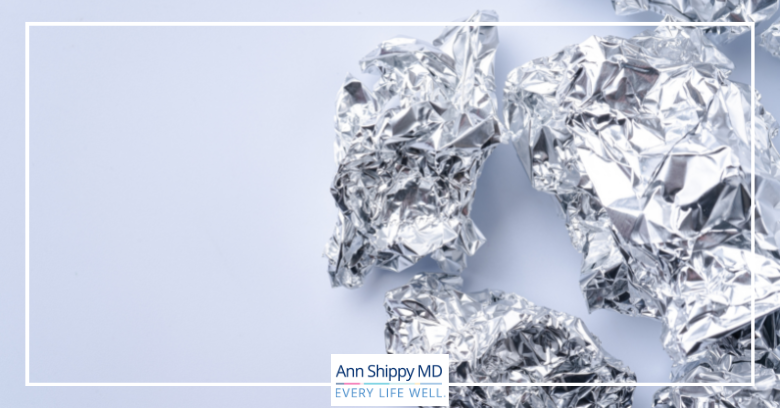Health Risks Of Aluminum Exposure
Aluminum might seem like a benign metal, one you most likely have in your home (tin foil), and don’t give much thought to, but is it really safe?
The amount of pure aluminum in the environment has been growing over time as aluminum is being used in a wider array of industry and consumer products.
More aluminum in the environment means more aluminum that our bodies are exposed to.
Aluminum doesn’t have any benefit inside the human body, and growing evidence points to its toxicity, raising safety concerns.
Let’s look at the science of aluminum today:
- What is aluminum and the difference between natural aluminum found in ore and pure aluminum metal
- Where we find aluminum in the environment and the most common places we are exposed in our daily lives
- How aluminum affects the body and what diseases and conditions it has been linked to
- Simple steps to reduce aluminum exposure for you and your family
What is aluminum?
Aluminum is the most abundant element in the Earth’s crust and the most abundant metal on the planet. Despite its prevalence, living organisms are not known to require or use aluminum. Previous to industrialization, aluminum rarely made its way into the human body.
In nature, aluminum is not pure. It naturally exists bound up with other elements in ore (in rocks).
It’s only been through the human extraction of aluminum metal from ore that has introduced pure aluminum into the environment and the human body. While the ore is inert, aluminum itself is reactive.
Aluminum is perceived as a cost-effective and safe natural resource, but as you’ll see, it’s anything but.
Human Aluminum Exposure
The truth is aluminum is toxic and we are facing larger environmental exposures than ever before. To meet global demand, industry produces 24 pounds of aluminum metal for each of the 7 billion people on Earth!
In 1950, most humans were exposed to around 1 mg of aluminum per day and by 2050 this is projected to be 100 mg of aluminum per day.
We are exposed to aluminum through:
- the food we eat, both in the food itself and how it is prepared,
- the air we breathe,
- the water we drink,
- the pills we pop
- and through products we apply to the skin.
We are exposed to aluminum that is intentionally in products, but also through unintentional exposures where aluminum contamination is present.
Here are the main places where you’ll find aluminum in your daily life:
- Baking powder, anti-caking agents, artificial colors
- Baked goods, processed foods, fast food
- Canned food, including beverages
- Pots and pans, kitchen appliances and utensils
- Aluminum foil
- Deodorant and antiperspirant
- Sunscreen
- Lotion, creams, tanning lotions and other skin care products
- Hair care products
- Lipstick and other cosmetics
- Over-the-counter medications including antacids and aspirin
- Vaccines, allergy treatments
- Materials used in dentistry and surgery
- Occupational exposures, such as mining
- Contaminated, low-quality supplements
Through breathing outdoor air, we may be exposed to 1.4 micrograms of aluminum per day and up to 1.4 mg in industrialized areas.
Diet provides anywhere from one to 20 mg of aluminum per day, both in the food itself and from contamination from aluminum cans and cookware.
Antiperspirants and sunscreens might be the largest contributors to the body burden. One application of antiperspirant contributes two grams of aluminum and you can get five grams of aluminum on your skin from sunscreen use for a single beach day!
Aluminum can accumulate in the body and is found in bone, organs, tissues, blood, lymph; essentially deposited throughout the body.
The body excretes what aluminum it is able to through the kidneys, digestive tract, and the skin as sweat.
Aluminum Health Effects
Remember that aluminum is not an element that is used or needed by the body.
Prior to aluminum mining, levels in the human body were quite low. Now, nearly each of us has some level of accumulation in our bodies.
In the body aluminum acts as:
- A pro-oxidant (the opposite of an antioxidant) causing oxidative stress
- An excitotoxin that overstimulate the nervous system
- An inflammagen, setting off inflammatory cascades
- An immunogen, eliciting an immune response
- A mutagen or carcinogen, damaging DNA and promoting cell growth
- A microbiome disruptor, contributing to dysbiosis
Because of these actions, aluminum may be a contributor to many diseases throughout the body, from neurodegenerative diseases like Alzheimer’s to breast cancer.
While disease is often multifactorial, exposures to toxins often play a role.
A 2019 review found links between aluminum toxicity and the following conditions:
- Pneumonia
- Lung disease
- Heart disease and stroke
- Inflammatory bowel disease (Crohn’s disease and ulcerative colitis)
- Anemia
- Dementia and Alzheimer’s disease
- Autism
- Infertility
- Liver disease
- Breast cancer
- Pancreatic disease
- Diabetes
Aluminum And Breast Cancer
Aluminum exposure increases breast cancer risk. Systemic aluminum may contribute, along with the concentrated use of aluminum in the under arms from antiperspirants and other skin products, which exposes the breast tissue and lymph nodes to high levels of aluminum.
The reason aluminum is used in antiperspirants is because it prevents sweating. Ironically, sweating is one of the main ways that aluminum is cleared from the body. From a detoxification perspective, sweating is a good thing!
According to research, Aluminum may cause instability in the DNA and inappropriate cell growth and proliferation of breast cancer cells. In addition, aluminum is an endocrine disruptor, with known estrogen-mimicking effects.
Breast tissue is particularly susceptible to estrogen-like chemicals.
Antiperspirants and deodorants often contain additional toxins including triclosan, parabens, fragrance and phthalates, which act as endocrine disruptors and contribute to the toxic burden in the area.
The use of deodorants and other under arm cosmetics may increase the risk of breast cancer, especially when use begins at an early age.
How To Reduce Aluminum
There is no normal level of aluminum in the body. Because aluminum is so widespread in the environment, the goal isn’t to eliminate all aluminum you come into contact with, or even spend that much time stressing about it.
Instead, a few simple changes in your lifestyle can significantly reduce aluminum exposure.
Let’s focus on the heavy hitters. Here’s how:
1. Use non-aluminum deodorant, such as Sumbody Deodorant, and avoid antiperspirants. Go through all of your personal care products and cosmetics using the EWG Skin Deep Database and upgrade to non-toxic options where indicated.
2. Choose safe, non-aluminum cookware, such as cast iron, enameled cast iron, stainless steel and glass. While you are ditching aluminum, it is helpful to ditch the plastic as well.
3. Avoid canned foods and cooking in aluminum foil. Choose whole, fresh foods that you cook at home. Instead of aluminum foil, use baking dishes with lids, parchment paper, reusable silicone baking sheets or a stainless steel basket for grilling.
4. Drink beverages out of glass rather than aluminum cans or plastic.
5. Filter your drinking water. This simple intervention eliminates a lot of toxins that find their way into the water supply. AquaTru is an easy and affordable countertop option.
6. Support aluminum excretion. Make sure you are having daily bowel movements, staying hydrated, and are sweating several times a week. An infrared sauna is powerful detoxification support.
7. Choose high quality supplements that have been tested for quality and purity. Talk with your doctor about your medications to see if they contain aluminum or other excipients.
While the larger issue of aluminum mining and use may seem overwhelming, drastically cutting our personal exposures is quite simple and begins with a few steps outlined here.
The first being thinking twice about what we are putting under our arms and on our skin each day. Simple actions have profound impacts for our own health and positively influence those around us. It all starts with knowledge and awareness.
References
- https://pubs.rsc.org/en/content/articlehtml/2013/em/c3em00374d
- https://www.ncbi.nlm.nih.gov/pmc/articles/PMC7409391/.
- https://www.ncbi.nlm.nih.gov/pmc/articles/PMC7071840/
- https://pubmed.ncbi.nlm.nih.gov/26997127/
- https://pubmed.ncbi.nlm.nih.gov/25233067/
- https://www.ncbi.nlm.nih.gov/pmc/articles/PMC5514401/
- https://www.ncbi.nlm.nih.gov/pmc/articles/PMC8364537/
- https://www.ncbi.nlm.nih.gov/pmc/articles/PMC2939626/













